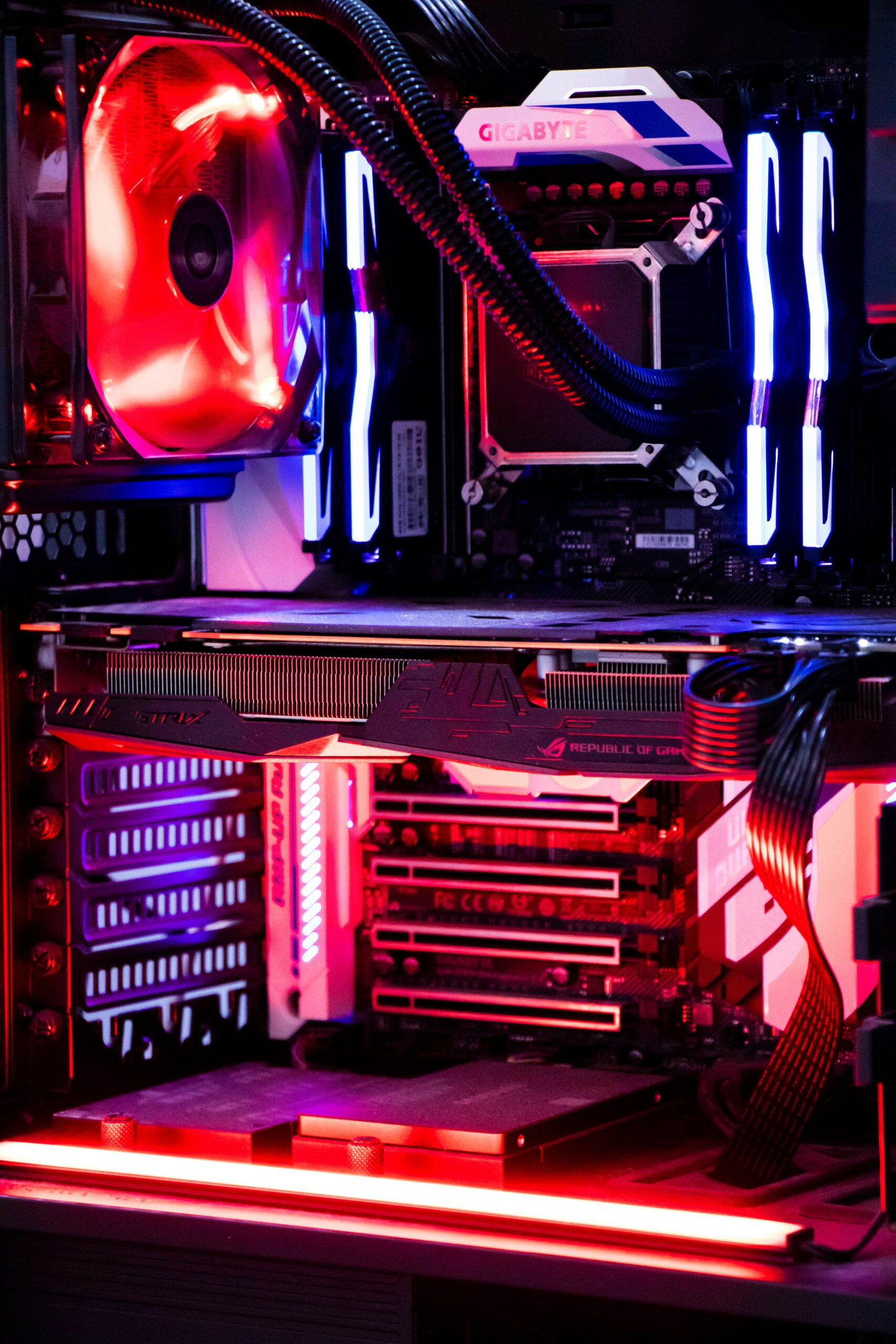Month: December 2019

For INAP employees, 2019 was the first full calendar year to live out the message of our new brand identity, revealed in late 2018: Performance for Your Purpose. IT pros know that the best infrastructure strategy depends on performance—on speed, resiliency and scalability. That’s why we work to make best-fit infrastructure strategies a reality through our industry-leading automation technologies, application-centric approach to solution engineering and a managed services and support philosophy that ensures our team is your team, bringing you our expertise on demand.
Here at the ThinkIT Blog, we aim to cover topics that will assist in living out this message through thought leadership, solution specific content and original industry research. Below is a list of our 10 favorite blogs from 2019. Check it out to see what you may have missed:
What Does IT Performance Really Mean?
IT is moving into the future, growing beyond its traditional role to become a center of innovation—so then why are conversations about IT performance stuck in the past? Josh Williams, VP, Solution Engineering, explores the definition of IT performance, stating that it must transcend “speeds and feeds” to encompass what technical performance enables your IT and your company to do, or in other words, how your IT is supporting your organization’s purpose.
60 Things IT Pros Wish CEOs Knew About Their Job

In an original survey conducted in early 2019, we asked 500 IT pros, “What’s the one thing you wish your CEO knew about your IT department/team?” Their answers ranged from straightforward and simple to humorous and even impassioned. INAP’s own CEO, Pete Aquino, even explained implications of the findings in an OpEd for Chief Executive.
Infrastructure for Online Gaming: Bare Metal and Colocation Reference Architecture

Bare Metal has quickly become the infrastructure solution of choice for gaming applications. It’s powerful, fast and, most importantly, easily scalable—all qualities that make it perfect for resource-intensive, dynamic applications like massive online games. And beyond that, Bare Metal offers performance and functionality at a competitive price, even when fully customized to your performance needs and unique requirements. Check out what a Bare Metal deployment for gaming might look like via a sample reference architecture.
The Flagship Series: INAP Phoenix Data Centers
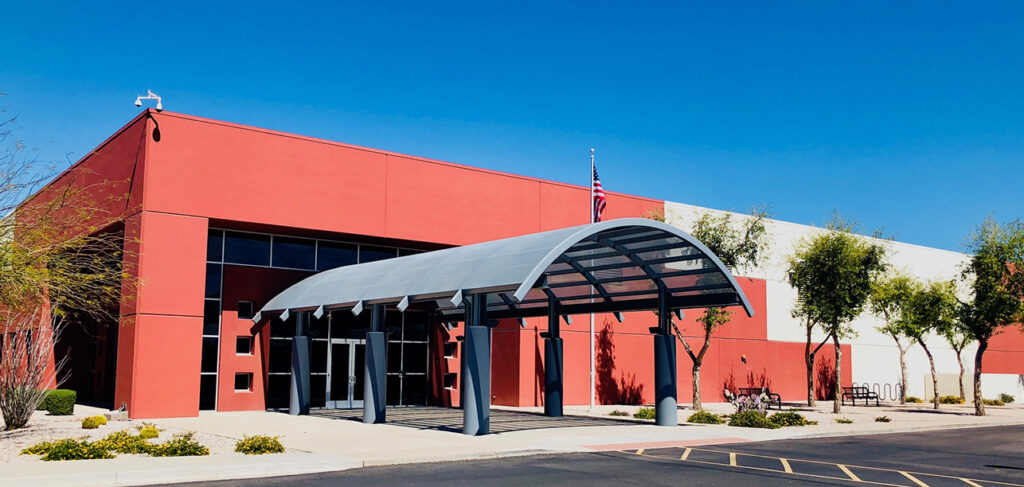
This year we debuted our Flagship Series, exploring INAP’s flagship data centers in various markets. First in the series was the latest addition to our data center portfolio—our facility in Phoenix, Ariz. The data center market here is among the fastest growing in the country, and favorable conditions indicate the boom will not slow down anytime soon. Learn about this and our other flagships by exploring the series.
Announcing INAP Spend Portability: Agility and Flexibility for Modern IT

There are times when changing up your infrastructure mix is necessary to meet your company’s needs. Launched in spring, INAP Spend Portability provides solution flexibility after you deploy your initial solution. Exchange infrastructure environments a year (or later) into your contract with our spend portability program. In this blog, Dan Beers, VP, Colo BU Operations Services, explains how you can focus on current-state IT needs knowing you can adapt for future-state realities through this program.
Sovrn Advances Digital Advertising with Engagement-Focused Tech

INAP customer, Sovrn, provides digital advertising tools, technologies and services to help independent publishers grow their audiences and make money through engaging ad content. We spoke to Sovrn CTO, Jesse Demmel, on the company’s //Signal product, why it’s different, and the elements of their data center and network strategy that keep their business growing.
Three Reasons Why We Built Intelligent Monitoring, Powered by INblue
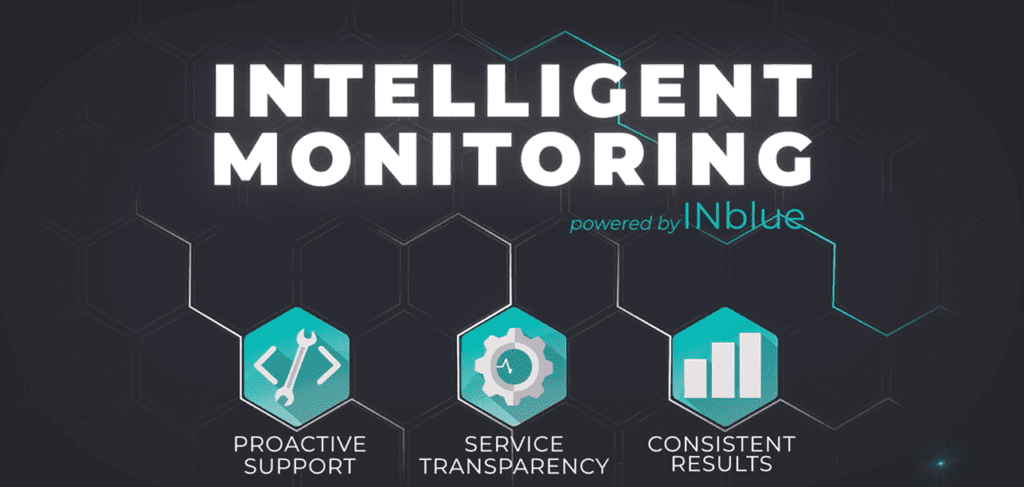
In July, we released our first-of-its-kind cloud infrastructure monitoring solution, Intelligent Monitoring, powered by INAP INblue, which provides greater transparency, drives results and gives IT infrastructure pros time back for what matters most. Jennifer Curry, SVP, Global Cloud Services, goes in depth on why we created Intelligent Monitoring.
How to Implement Microsoft SQL Servers in a Private Cloud for Maximum Performance

There are many considerations to take into account when implementing a Microsoft SQL Server in a private cloud environment. Today’s SQL dependent applications have different performance and high availability (HA) requirements. Solution Engineer Rob Lerner covers performance considerations to ensure that your SQL Server environment is ready to meet application, growth and DR requirements for your organization.
New Survey Report: The State of IT Infrastructure Management
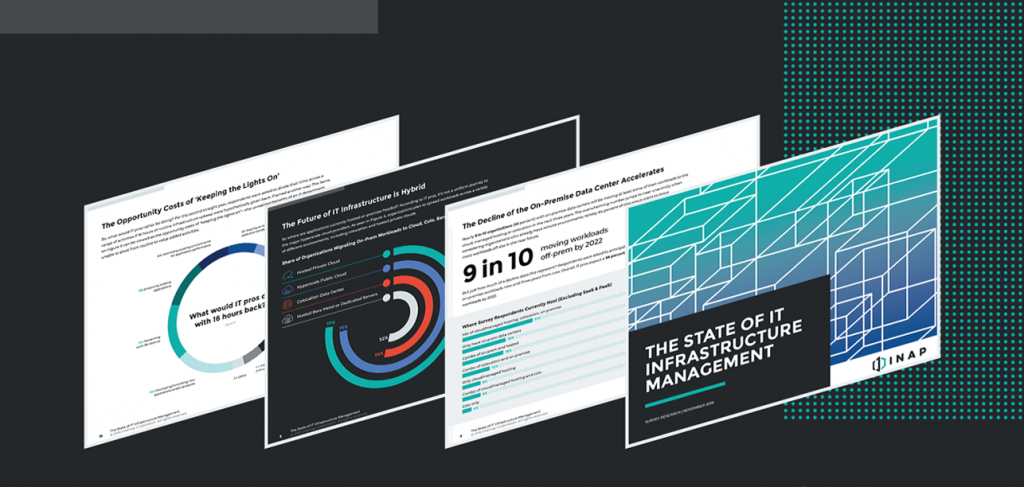
INAP surveyed 500 IT professionals with data center, server and cloud infrastructure responsibilities at companies in the U.S. and Canada to create the second annual State of IT Infrastructure Management report. In this year’s report, we delve further into what’s driving the decline of on-premise data centers and highlight the factors associated with successful infrastructure strategies in the hybrid and multicloud era. This report has been covered by several news outlets, including CIO Dive, Information Management and Tech Republic.
Be sure to check the ThinkIT Blog regularly so you don’t miss a thing in 2020.
Explore HorizonIQ
Bare Metal
LEARN MORE
Stay Connected
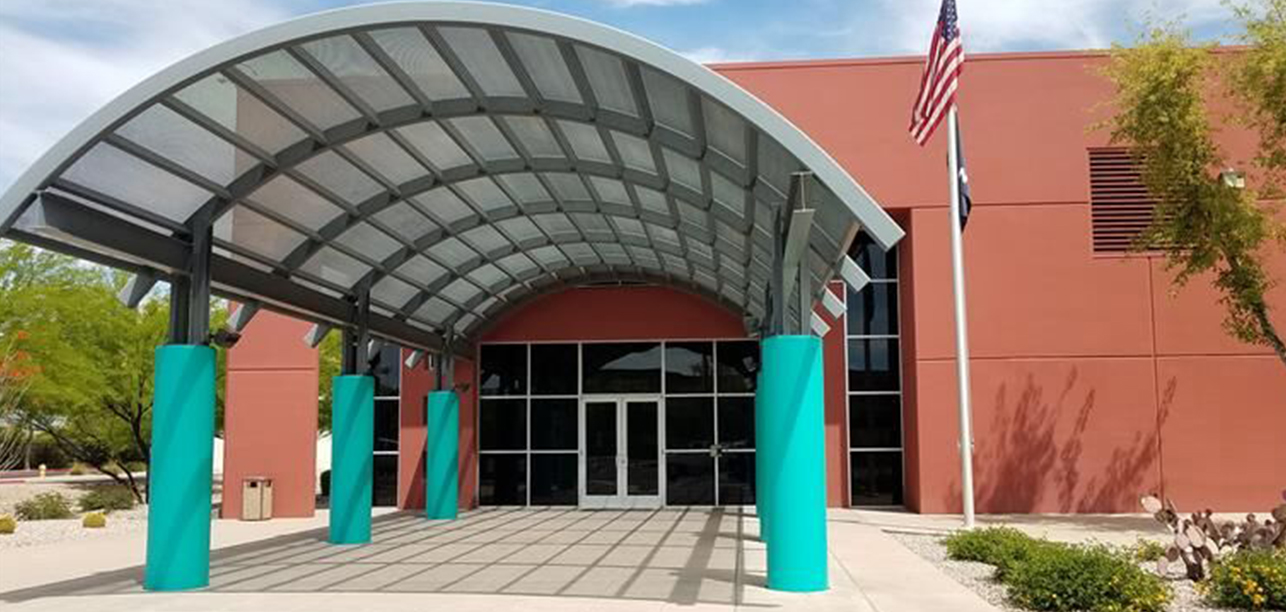
Check out the complete list of blog posts on INAP’s flagship data centers and their surrounding markets:
 Seattle Data Center Market Overview
Seattle Data Center Market Overview
It’s fitting that a city known for its cloudy days in home to two of the largest players in cloud computing. The Seattle data center market is growing, bolstered by local industry, Northern California-based expansions and cloud infrastructure investments from Microsoft and Amazon. INAP, which was founded in Seattle in 1996, maintains two flagship facilities and a POP in the market. With our suite of Connectivity Solutions – Cloud Connect, Metro Connect and Network Connect, you can reliably link your infrastructure with endpoints in public clouds throughout Seattle and around the globe.
![]()
Silicon Valley Data Center Market Overview
As the preeminent technology hub of the United States, the Silicon Valley data center market is among the largest in the country. INAP has seven data centers and POPs in the Silicon Valley, and an additional four locations in the Bay Area and Sacramento. The Silicon Valley flagship facility is located in Santa Clara at 2151 Mission College Blvd. The 75,000 square-foot data center is designed with Tier 3 compliant attributes and offers 10 MW of utility power.

New York & New Jersey Data Center Market Overview
The New York city metro area—the largest in the U.S.— requires a robust data center market to readily deliver service to 20.1 million people living in the area. INAP has seven data centers and points of presence in the New York/New Jersey metro area, with our flagship facility located in Secaucus, N.J., at 1 Enterprise Avenue. The 101,000 square-foot flagship data center is designed with Tier 3 compliant attributes and offers high-density configurations including cages, cabinets and suites.

Dallas Data Center Market Overview
Dallas is one of the top three data center markets in the U.S. And with favorable business taxes, low power costs, low risk for disasters and the availability of trained professionals, it’s no wonder why this market is so popular. Our INAP data centers in Dallas are strategically positioned to leverage the benefits of the region and to offer customers the connectivity they desire.

Boston Data Center Market Overview
Boston is the east coast hub for colocation. Home to some of the nation’s most prestigious universities and at the forefront of research and development in a number of growing industries, Boston is a market for companies looking to colocate close to their users. Our Boston-area flagship is strategically located 10 minutes from downtown and Logan International Airport, outside of flood plains and seismic zones to help give you extra peace of mind.
 Atlanta Data Center Market Overview
Atlanta Data Center Market Overview
Atlanta is the southeastern data center hub and ranks in the top five markets for bandwidth access. Our Atlanta Data Centers—one located downtown and the other on the perimeter of the city—offer a reliable, high-performing backbone connection to Washington, D.C. and Dallas through our private fiber. INAP customers in these flagship data centers avoid single points of failure with our high-capacity metro network rings.
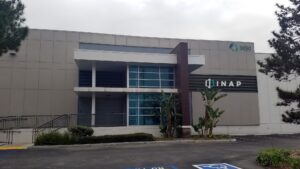
Los Angeles Data Center Market Overview
The Los Angeles data center market is in high demand. INAP has six data centers and points of presence in the Los Angeles metro area, with our flagship facility located in Redondo Beach at 3690 Redondo Beach Avenue. The 105,000 square-foot data center is designed with Tier 3 compliant attributes and offers high-density configurations including cages, cabinets and suites.
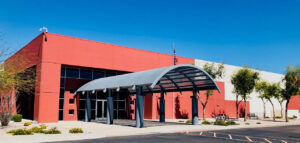
Phoenix Data Center Market Overview
Phoenix, Arizona’s data center market is among the fastest growing in the country, and favorable conditions indicate the boom will not slow down anytime soon. Located in the southeast sector of the Phoenix metro, INAP’s Chandler, Arizona, facility at 2500 W Frye Rd, is the most recent Tier 3-design data center to enter our portfolio of Flagships. Considering Phoenix data centers for a colocation, network or cloud solution? There are several reasons why we’re confident you’ll call INAP your future partner.
Explore HorizonIQ
Bare Metal
LEARN MORE
Stay Connected

Survey: The Top Challenges Facing IT Departments in 2020
There will be no shortage of strategic challenges confronting IT leaders and infrastructure managers in 2020, but one issue rises above the pack: Migrating applications to the cloud. That’s according to new survey data published this week by INAP at Gartner’s IT Infrastructure, Operations and Cloud Strategies Conference in Las Vegas.
This is the second year INAP asked 500 IT professionals with cloud, server or data center management responsibilities to select their top three challenges from a list of perennial issues.
The results showcase a reshuffling of the leading challenges, with cloud migrations supplanting 2019’s No. 1 answer—“protecting the organization from cyberattacks”—for the top spot in 2020. Take a look at the full list here and read on for analysis and commentary from INAP experts.
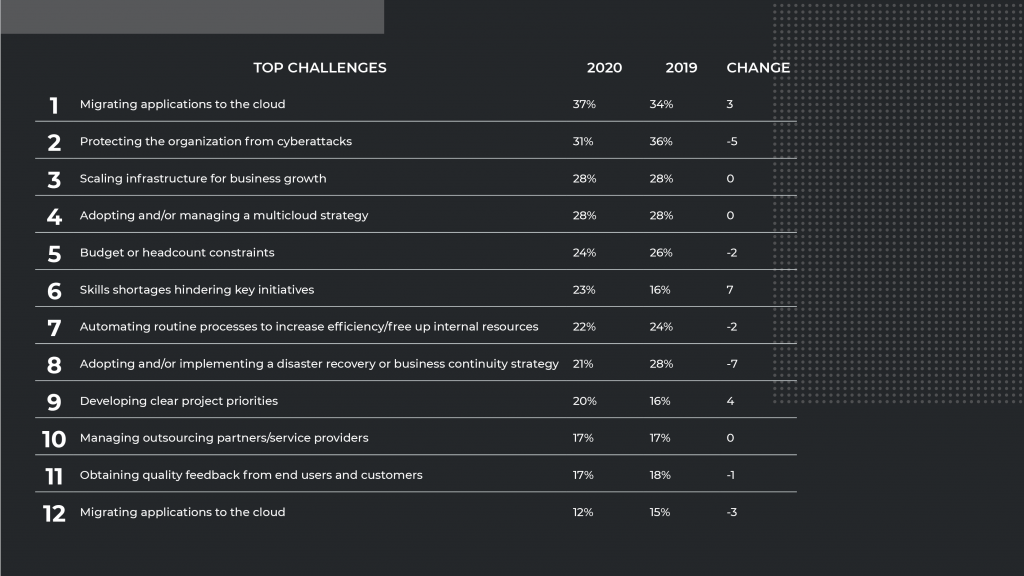
“Migrating applications to the cloud” sits six points above the rest of the list, and “adopting and/or managing a multicloud strategy” will be a top challenge for 28 percent, tying for third. A simple look at market trends may explain why, according to Jennifer Curry, senior vice president of Global Cloud Services at INAP.
Overcoming Cloud Adoption Challenges
“We shouldn’t be surprised by the survey given the current forecasts around growth in the public cloud services market and infrastructure as a service spending,” said Curry, pointing to 12.6 percent CAGR and 27.5 percent CAGR in those respective areas between 2018-2022. “Cloud and IaaS are becoming easier to consume with container-based solutions and more applications that are born in the cloud or are cloud-ready. This also makes it easier to put your workloads in the environment where they work best – businesses don’t have to subscribe to an all-in or all-out strategy.”
But that doesn’t mean making the journey to the cloud is without its hurdles.
“Cost overruns are the biggest consequences of migrations gone awry,” said Curry. “Delays caused by application performance issues, downtime caused by botched migrations, unexpected security and compliance issues—all of these issues cost money.”
Once new cloud environments come online, the work is far from over, as each need to be monitored and optimized on an ongoing basis. The key to overcoming all of these challenges is a mix of people and prep work, according Curry.
“Ensure you have all the right skills inside of your organization or the right third-party partners to get the most value out of your multicloud strategy,” she said. “It’s also critical to understand where all of your workloads belong and what your true goals are. Is it to move everything off premise in a lift and shift, or is the real goal to optimize and transform with a combination of IaaS, PaaS and SaaS? Being able to define the business value is key to designing the multicloud environment.”
Cybersecurity Challenges Still Paramount
Although it dropped five points from last year’s poll, protecting against cyberattacks is the only other challenge selected by greater than 30 percent of IT leaders and infrastructure managers.
“Cyber attacks are no longer just system or nuisance attacks,” said Jeff Atkinson, Chief Information Officer of INAP. “They’ve gotten much more sophisticated and, in some ways, easier for perpetrators to conduct. This has opened up a much larger world of potential threats and targets—putting organizations of all shapes and sizes in the crosshairs. Given that almost all industries are reliant on some form of digital footprint, it has to be a primary concern to the business and by extension, IT.”
Most IT Pros Agree Budget Shouldn’t Be an Issue in 2020
Budget or headcount constraints is a challenge for 24 percent of IT pros, dropping slightly from 26 percent last year. Separately, respondents were asked to agree or disagree with the following statement:
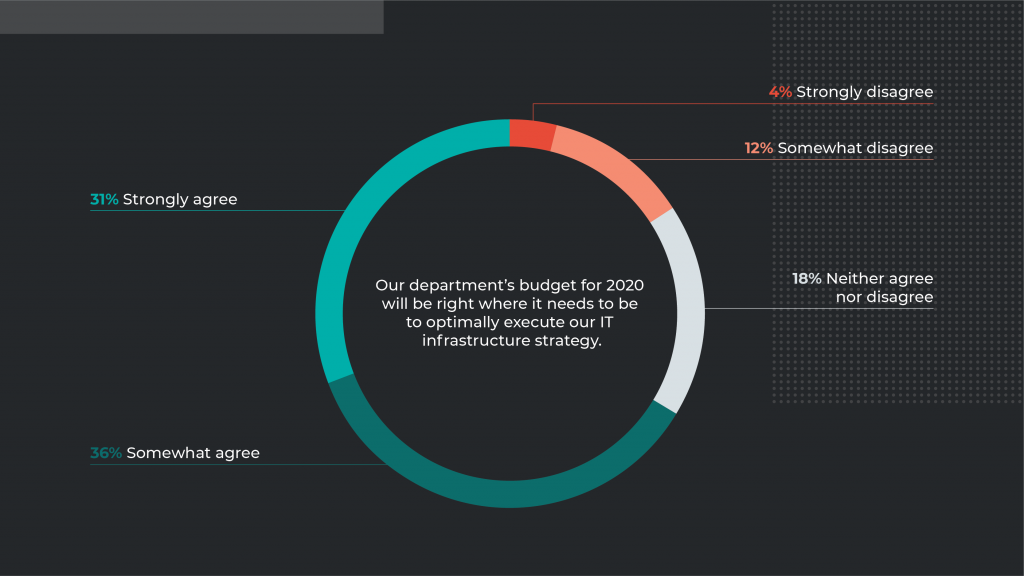
Despite a strong majority agreeing that IT budgets will be in a good spot for 2020, the confidence waned slightly for non-senior leaders. Of this group, 1 in 4 disagreed with the statement and only 14% strongly feel their budget will be optimal.
Biggest Movers: Skills Shortage Concerns Mount; Disaster Recovery Challenges Wane
The biggest movers in this year’s list of challenges are “skills shortages hindering key initiatives” (+7) and “adopting and/or implementing a disaster recovery or business continuity strategy” (-7).
While disaster recovery may simply be less of roadblock as more economically viable and cloud-enabled replication solutions gain popularity, skills shortages in specialty areas may be an issue to watch due to the growing scope of the IT function, according to Atkinson.
“Every company has some need for IT talent and thus are all competing for the same people,” he said. “This challenge is increased if the skills needed are specialized. Because of this, the IT industry will continue to move to outsourced solutions, allowing companies to put more toward attracting and retaining the specialized talent needed.”
About the Data
The data reflected in this report was derived from a survey of 508 IT professionals with data center, server and cloud infrastructure responsibilities who work at businesses and enterprises in the United States and Canada with greater than 100 employees. The survey, commissioned by INAP and facilitated by Precision Sample, was conducted in October 2019. The margin of error is ±5 percent at the 90 percent confidence level.
Explore HorizonIQ
Bare Metal
LEARN MORE
Stay Connected

New Survey Reveals the Big 4 Reasons Behind Cloud Migrations and the Off-Premise Exodus
Organizations continue to migrate their IT infrastructure off-premise, and this trend is not slowing down any time soon. INAP’s 2019 State of IT Infrastructure Management survey, released in November, revealed that nearly 9 in 10 organizations (88 percent) will be migrating at least some workloads off-premise in the next three years.
This already high percentage jumps to an even greater level when only looking at organizations that already have remote environments. Ninety-six percent of this group plans to move more workloads off-prem in the near future.
For this second annual survey, participants—500 IT leaders and infrastructure managers—were asked why they are moving workloads off-prem, and where those workloads are going. The results indicate four big reasons for moving off-prem, as well as the share of companies migrating workloads to cloud, colo and bare metal.
If you haven’t checked out the survey report yet, read up on it here, or download the full report below.
Why Companies are Moving Off-Premise
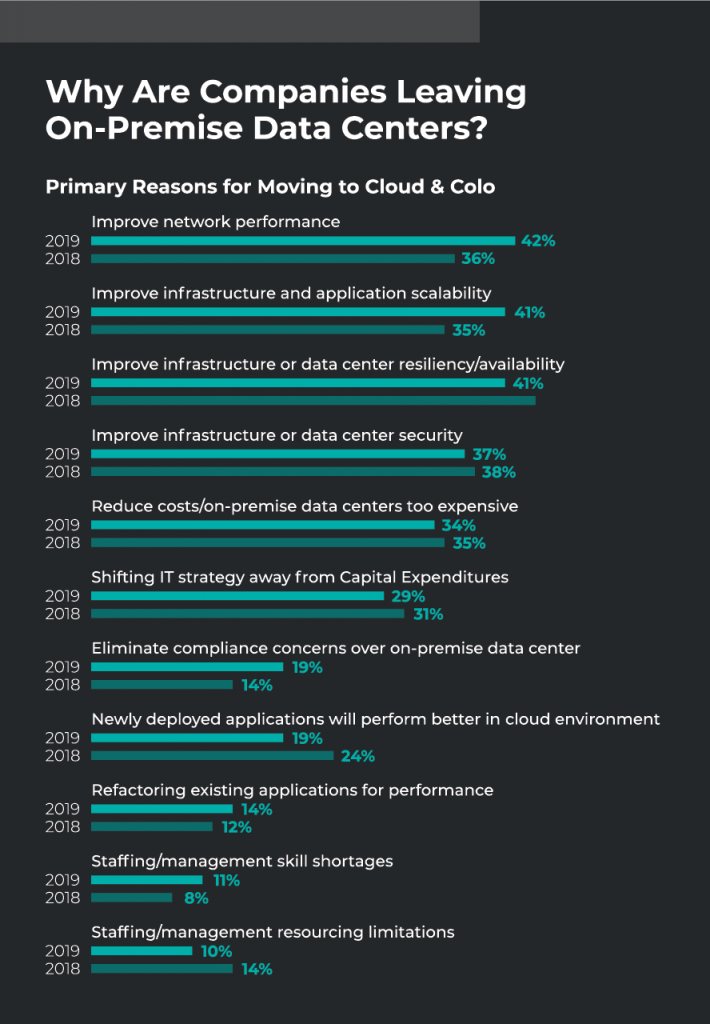
The data above compares the 2018 and 2019 results of the survey. The clear top four reasons for 2019—network, scalability, resiliency and security—make a compelling case for why the demise of the on-premise data center is perhaps inevitable within the next decade. Let’s explore this year’s top reasons in greater depth.
Improve Network Performance
Jumping up six points from 2018, where it ranked No. 3 overall, network performance has claimed the No. 1 spot for reasons to move off-premise. Ultra-low latency and high availability is critically important to end users (think multi-player gamers, streaming customers, Ad Tech and financial service consumers, etc.) and can make the difference between retaining customers or losing them to a competitor. Additionally, conversations around the importance of Edge Computing and Edge Networking strategies continue to grow in prominence, meaning network performance will only grow more important.
Accomplishing both low latency and high availability requires not only more bandwidth, but better infrastructure to serve end users at the edge. Alternatively, organizations can take advantage of network route optimization technologies to ensure traffic is always sent along the lowest-latency path.
Whichever path an organization chooses to take, it’s clear that traditional on-premise data centers are increasingly incapable of delivering the performance today’s digital economy demands. To truly compete in the current and future tech landscape, strong network performance is a requirement, not a necessity.
Application Scalability and Resiliency
The No. 2 (scalability) and No. 3 (resiliency) reasons are both essential components of running workloads and applications in the digital economy. Infrastructure as a Service (IaaS) solutions deliver these attributes via on-demand deployment, and colocation data centers deliver them via greater space and power capacity, each offering companies the ability to add resources easier and more efficiently than they can with the average on-premise facility.
Additionally, any quality off-premise solution will include component and utility redundancy, enabling up-time of 99.999 percent annually. A single point of failure, whether it’s related to electrical, power or cooling, for example, will not disrupt your service in a Tier 3 data center run and maintained by a reliable partner.
Infrastructure and Data Center Security
Cyberattacks continue to grow in sophistication and frequency. Earlier this year, we rounded up sobering statistics on the state of cybersecurity. Did you know that it takes an organization 34 days on average to patch for critical common vulnerabilities and exposures? And did you also know that a successful phishing attempt will cost small or medium business $1.6 million on average? It’s no wonder security ranked No. 4 as a reason to move off-premise.
As information security initiatives attract more attention from the C-suite, in-house IT infrastructure and operations leaders will continue to view on-premise facilities as a vulnerability. The levels of physical and network security offered by leading cloud and data center providers goes above and beyond what an on-premise operation can achieve. The security and compliance-ready attributes of Tier 3 data center facilities instantly tick several “best-practice” boxes, giving IT pros and the C-suite alike peace of mind, not to mention assurance that their infrastructure will be ready to stand up to future threats.
Additionally, more companies are choosing to offload the day-to-day management of common security functions like monitoring, log management and patch management. For instance, a fully managed hosted private cloud offers the scalability and security that organizations are looking for and allows them to work with a trusted partner to deploy the best-fit solution for applications and workloads.
The Future of IT Infrastructure is Hybrid
Now that we understand why organizations are headed off-prem, let’s explore where they are moving. We asked survey participants to choose from non-Software as a Service (SaaS) and non-Platform as a Service (PaaS) environments, including hosted private cloud, hyperscale public cloud, colocation data center and hosted bare metal or dedicated servers. The participants were able to select all options that applied.
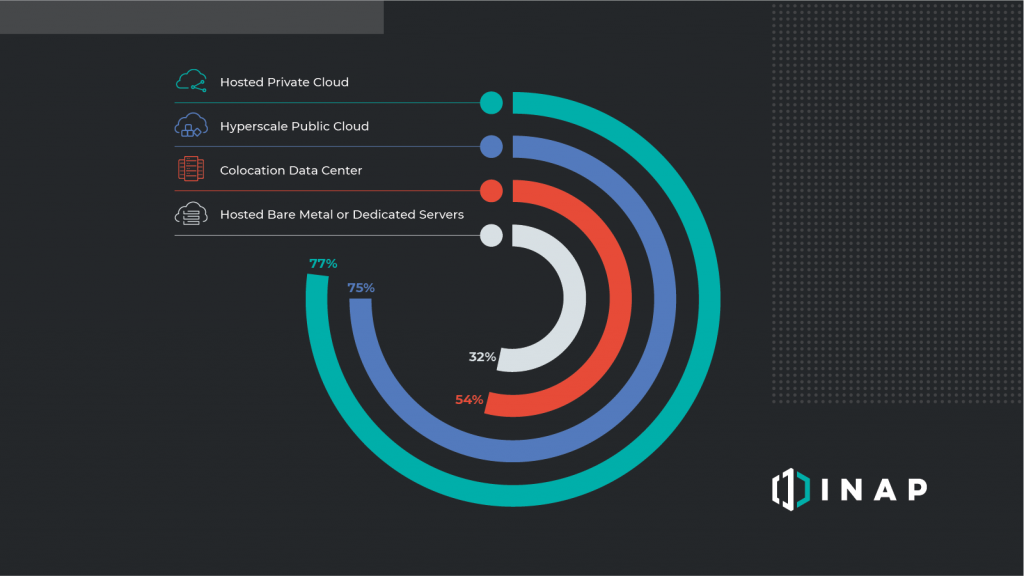
Based on the results, we learned that it’s not a uniform journey to the major hyperscale cloud providers. Organizations plan to spread workloads across a variety of different environments, including colocation and hosted private clouds, with the later just outpacing the hyperscalers at 77 percent.
Between colocation and the different types of clouds, organizations have plenty of choice when it comes to their off-premise infrastructure, and there is no one-size-fits-all best solution. In this hybrid era of IT, it will be important for organizations to evaluate their infrastructure strategies for to ensure that their chosen solutions (cloud, colo, etc.) are best meeting workload requirements.
“All of that infrastructure spread out across multiple data centers and clouds needs to be centrally managed, monitored and secured with efficiency,” says Jennifer Curry, INAP’s SVP, Global Cloud Services in TechRepublic’s coverage of the report. “This is no easy feat, so my recommendation would be to seek out partners who understand how to design performance-driven architectures and partners who can provide you the flexibility and support required to give your teams the peace of mind and the ability to focus on what matters most.”
The Off-Premise Acceleration
Just how fast will the on-premise data center exodus be? Respondents were asked to anticipate the percentage share of on-premise workloads now and three years from now in our latest survey. Overall, IT pros expect a 38 percent reduction in on-premise workloads by 2022. While there are myriad reasons to move away from on-prem infrastructures, the “Big 4” reasons present a compelling case for this migration.


